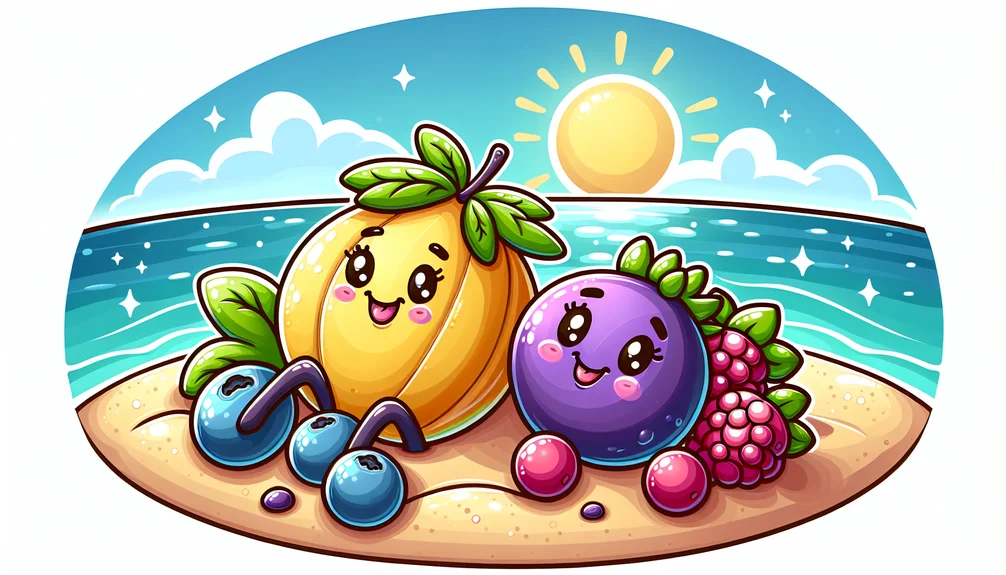20 Fruits That Starts With The Letter H

Today we will be sharing with you some amazing fruits that starts with the letter H. It's quite fascinating to see just how many fruits begin with this eighth letter of the alphabet, and even more intriguing to dive into the particularities and nutritional benefits they offer.
You will learn about unique fruits from around the globe and possibly find new favorites to include in your diet.
See also: More Fruits That Start With
Fruit Trivia Question
What fruit is known as the "King of Fruits" and is famous for its strong odor? (Answer at the end of the article!)
Fruits That Start With The Letter H
Hackberry
Hackberry, known scientifically as Celtis occidentalis, is a small berry from the hackberry tree. Native to North America, this fruit is small, sweet, and packed with nutrients—rich in vitamins C and E, fiber, and essential minerals. Hackberries have a crunchy texture and are often compared to a mix between a date and a pea. They offer health benefits such as boosting the immune system and aiding digestion. There aren't any well-known allergies associated with hackberries, and they are versatile in culinary uses, from jams to desserts, adding a sweet and nutritious boost to any meal.
Hala Fruit

The Hala Fruit, or Pandanus tectorius, is a species of Pandanus (screw pine) native to the Pacific Islands. The fruit itself is quite distinctive with its large, pineapple-like appearance and dozens of phalanges extending outward. Nutritionally, it is a source of fiber, vitamins, and minerals. The health benefits of Hala Fruit include aiding digestion and providing an energy boost. There are no common allergies to this fruit, and its parts are used in various culinary ways, including the consumption of its seeds and the use in traditional Pacific Islander cuisine.
Hardy Kiwi
Hardy Kiwi, or Actinidia arguta, a smaller cousin of the common kiwi, offers a sweet, tangy flavor without the need to peel off the fuzzy exterior. Originating from East Asia, this fruit is now grown in various parts of the world. Hardy Kiwi is rich in vitamin C, vitamin K, and dietary fiber, contributing to heart health and aiding digestion. While rare, some people may experience allergies similar to those associated with other kiwis. Culinary uses include fresh eating, salads, smoothies, and desserts, offering a delightful burst of flavor.
Haskap
Haskap berries, sometimes known as honeyberries, hail from colder climates and are revered for their blueberry-like appearance and unique tart flavor. These berries are packed with antioxidants, vitamin C, and fiber, promoting overall health and bolstering the immune system. Haskap berries typically don't cause allergies and are used in a variety of culinary dishes, from jams and jellies to baked goods, adding a twist of tartness and a pop of color.
Hawaiian Mountain Apple
The Hawaiian Mountain Apple (Syzygium malaccense) is a tropical fruit native to Malaysia and Indonesia. This crimson fruit is bell-shaped and offers a crisp, watermelon-like texture with a mildly sweet flavor. It’s a good source of vitamin C and dietary fiber. Eating Hawaiian Mountain Apple contributes to a healthy diet by providing hydration and aiding digestion. It rarely causes allergies and is commonly enjoyed raw or used in traditional Hawaiian dishes, such as poke.
Hawthorn Berry
Hawthorn Berry, from the species Crataegus, is widely known for its heart-health benefits. These small, red berries are native to temperate regions of the Northern Hemisphere. Nutritionally, they are a good source of antioxidants, flavonoids, and essential minerals. Hawthorn berries have been used traditionally to treat heart-related conditions, improve circulation, and support overall cardiovascular health. Cooking uses include making jellies, desserts, and even medicinal syrups, although there are no prevalent allergies associated with it.
Hebesu
Hebesu, a citrus fruit native to Japan, particularly the Miyazaki Prefecture, offers a unique, slightly bitter flavor that makes it stand out. This fruit is laden with vitamin C, making it excellent for immune support and skin health. Hebesu is often used in culinary applications, adding a zesty flavor to dressings, marinades, and traditional Japanese dishes, enhancing flavors with its distinct tartness.
Heirloom Tomato
Though not traditionally considered a fruit by many, the Heirloom Tomato is botanically a fruit and is cherished for its rich, vibrant flavors compared to regular tomatoes. Originating from several regions worldwide, these tomatoes offer a range of nutrients, including vitamins C and K, potassium, and folate. They support heart health and provide antioxidant properties. There are varieties of heirloom tomatoes without known allergies, making them a versatile and healthy addition to salads, sandwiches, and cooking.
Highbush Blueberry
The Highbush Blueberry, a North American native, is a popular fruit known for its sweet, juicy berries. These are nutritional powerhouses, high in antioxidants, vitamins C and K, and fiber. They support heart health and can help improve memory and cognitive function. Used in culinary applications such as pies, muffins, and smoothies, highbush blueberries are a deliciously healthy addition to any meal, with rare cases of allergies.
Highbush Cranberry
Contrary to its name, the Highbush Cranberry isn't a true cranberry, though the fruits resemble those of Vaccinium species. Native to North America, these berries are used primarily in jams, jellies, and sauces. They are recognized for their high vitamin C content and potential for alleviating urinary tract infections. There aren't prevalent allergies, making it a great addition to the culinary world for its tart flavor.
Himalayan Mulberry

Himalayan Mulberry trees produce long, juicy berries that are admired for their sweetness and health benefits. Rich in vitamins C and K, iron, and resveratrol, these berries support the immune system, aid in bone health, and have anti-inflammatory properties. Culinary uses are diverse, including jams, desserts, and smoothies. Allergies are uncommon, making them a fantastic fruit to explore in various dishes.
Hog Plum
Hog Plum, belonging to the genus Spondias, is a tropical fruit known for its tangy taste and crunchy texture. It is a good source of vitamins C and A, dietary fiber, and antioxidants. Hog Plum promotes digestive health and boosts the immune system. Though allergies are rare, its culinary uses are varied, including pickles, chutneys, and refreshing drinks, making it a versatile fruit in tropical cuisine.
Honey Crisp Apple
The Honey Crisp Apple, developed in the United States, is beloved for its exceptional sweetness, crisp texture, and juicy bite. This apple variety is a nutritional snack offering fiber, vitamins C and K, and potassium. Eating Honey Crisp Apples supports heart health and weight management. They're generally allergy-friendly and are perfect for eating fresh or using in a wide array of dishes, from salads to baked goods.
Honey Locust
The Honey Locust tree produces pods that, unlike its name suggests, do not contain honey but a sweet, edible pulp. This tree, native to North America, offers a nutritious snack that was historically eaten by Native Americans. The pods are rich in sugar and nutrients, though not commonly allergenic, and have limited but interesting culinary uses, primarily as a natural sweetener.
Honeyberry
Honeyberry, similar to Haskap, is rich in antioxidants, vitamins C and A, and fiber. These berries support immune health and are known for their anti-inflammatory properties. Honeyberries are versatile in the kitchen, used in jams, baking, and beverages. With minimal allergy concerns, they're a delightful addition to any diet.
Honeydew
Honeydew melons are a refreshing summer favorite, packed with hydration and nutrients like vitamin C, potassium, and fiber. They support hydration, digestion, and heart health. Typically, there are no allergies associated with Honeydew melons, making them a safe and healthy choice for most people. Culinary uses are diverse, including fresh salads, smoothies, and desserts.
Honeysuckle
Honeysuckle, known for its beautifully fragrant flowers, produces edible berries that are often overlooked. While not all species produce edible fruit, those that do offer a source of anti-inflammatory and antioxidant properties. The berries are not commonly consumed but offer an interesting exploration in herbal teas and syrups.
Horned Melon
The Horned Melon, or Kiwano, is recognized by its spiky exterior and vibrant green, jelly-like interior. It's a source of vitamins C and A, antioxidants, and magnesium. This fruit aids hydration and supports heart and brain health. With its unique texture and flavor, it adds a tropical twist to salads, desserts, and cocktails. Horned Melons generally do not cause allergies, making them a fun, exotic fruit to try.
Huckleberry
Huckleberry, native to North America, resembles the blueberry but offers its distinct taste and slightly larger seeds. These berries are a nutritional treat, rich in antioxidants, vitamin C, and iron, supporting heart health and boosting the immune system. Huckleberries are used in a variety of culinary applications, from pies and jams to savory sauces, providing a delightful burst of flavor.
Fruit Trivia Answer
The King of Fruits is the Durian.
Final Thoughts on Fruits That Starts With The Letter H
We hope that you have learned something new and exciting about the diverse world of fruits starting with the letter H. Each fruit, from the sweet and tangy Hardy Kiwi to the exotic and spiky Horned Melon, brings its unique set of nutrients, flavors, and potential health benefits. Hawaiian Mountain Apple and Huckleberry especially showcase the vast variety and richness that nature offers.
Healthy eating is not just about including fruits and vegetables in your diet but exploring the wide variety that exists and enjoying the bounty of flavors and nutritional benefits they provide. We encourage you to experiment with these fruits in your culinary adventures and discover new favorites that not only taste great but also contribute positively to your health and well-being.

Related Posts